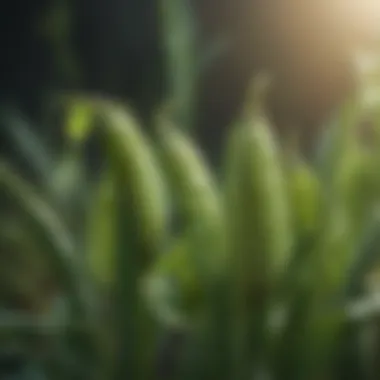Expert Guide to Maximizing Pea Growth in Your Garden for Optimal Results


Plant Growth Requirements
Soil Preparation
To maximize pea growth in your garden, it is crucial to start with adequate soil preparation. Choose a well-draining soil rich in organic matter to provide essential nutrients for the plants' development. Additionally, ensure the soil pH levels are within the optimal range of 6.0 to 7.5.
Sunlight Exposure
Peas thrive in full sunlight, requiring at least 6-8 hours of direct sunlight daily. Select a planting location that receives ample sunlight to promote vigorous growth and abundant flowering.
Watering Schedule
Proper watering is key to pea growth. Maintain consistent soil moisture by watering the plants deeply once or twice a week, allowing the soil to dry slightly between waterings to prevent waterlogged conditions.
Trellising Techniques
Supporting pea plants with trellises or stakes is essential for maximizing growth and optimizing space utilization. Train the vines to climb the supports, ensuring adequate air circulation and sunlight exposure for healthy growth.
Pest and Disease Management
Implement pest and disease control measures to safeguard pea plants from common threats. Regularly monitor for pests like aphids and caterpillars, and promptly address any signs of disease or nutrient deficiencies to maintain plant health.
Harvesting and Storage
Optimal Harvest Timing
To harvest peas at their peak flavor and tenderness, it is important to monitor the pods regularly. Harvest when the pods are plump and bright green, before the peas become overly mature and lose their sweetness.
Proper Storage Methods
After harvesting, store peas in a cool, dry place to retain their freshness and flavor. Consider blanching peas before freezing for long-term storage, preserving their nutritional value and texture.
Seed Saving Techniques
For gardeners interested in seed saving, allow a portion of the pea crop to mature fully on the vine. Harvest the mature pods, shell them carefully, and store the seeds in a cool, dry location for future planting.
Nutritional Value
Peas are rich in essential nutrients, including vitamins A, C, and K, as well as dietary fiber and plant-based protein. Incorporate freshly harvested peas into your diet to enjoy their nutritional benefits and vibrant flavor.
Culinary Applications
From stir-fries to salads, peas are versatile ingredients that add texture and taste to various dishes. Experiment with different cooking methods and recipes to explore the culinary possibilities of this nutritious legume.


Creative Gardening Ideas
Enhance your garden space by creatively incorporating peas into your landscape. Consider companion planting with other vegetables or flowers to promote biodiversity and maximize garden productivity.
Conclusion
Introduction
The cultivation of peas in one's garden is a pursuit that blends the art of gardening with the satisfaction of reaping a bountiful harvest. As we delve into the realm of maximizing pea growth, we are embarking on a journey that promises not only verdant greenery but a deeper understanding of plant biology and environmental considerations. Peas, with their delicate tendrils and vibrant pods, offer a canvas for exploration for both the novice and seasoned cultivator. This article serves as a beacon, guiding us through the nuances of pea cultivation and offering a trove of knowledge to enrich our gardening endeavors.
In this comprehensive guide, we will traverse the intricate landscape of pea cultivation, from the initial selection of pea varieties to the nuanced techniques of maintaining healthy pea plants. Understanding the nuances of each stage in the growth cycle of peas is paramount to achieving a flourishing garden. Through practical insights and horticultural wisdom, we aim to equip every enthusiast with the tools needed to nurture thriving pea plants under their care.
The relevance of this guide transcends mere gardening tips; it delves into the very essence of sustainable living and self-sufficiency. By mastering the art of pea cultivation, individuals can embrace a more holistic approach to food production, fostering a deeper connection with the natural world. Moreover, the joy derived from witnessing the development of pea plants from seedlings to harvest-ready pods is a reward that transcends the tangible outcome of fresh produce.
Choosing the Right Pea Variety
Understanding Ideal Temperature Ranges
One crucial aspect to consider when selecting the right pea variety is the ideal temperature range for growth. Certain pea varieties thrive in cooler temperatures, while others prefer warmer climates. By understanding the ideal temperature ranges for different pea varieties, you can ensure optimal growth conditions for your plants. This knowledge allows you to provide the necessary environment for your chosen pea variety, enhancing its overall performance in your garden.
Adapting to Different Climate Zones
Furthermore, adapting your choice of pea variety to suit your specific climate zone is imperative for successful growth. Different climate zones present varying challenges and opportunities for pea cultivation. By selecting a pea variety that is well-adapted to your particular climate, you can maximize growth potential and productivity. Adapting to different climate zones ensures that your pea plants receive the ideal conditions they need to flourish, resulting in healthy and thriving harvests.
Determining Planting Season
Understanding Early Spring vs. Fall Planting
When deciding between early spring and fall planting, it is essential to weigh the benefits and drawbacks of each approach. Early spring planting allows for an extended growing season, taking advantage of mild temperatures and ample sunlight. On the other hand, fall planting offers cooler conditions that some pea varieties prefer, leading to improved yields. By comprehensively understanding the differences between early spring and fall planting, you can make an informed decision that suits your gardening goals and preferences.
Choosing Between Snap, Snow, or Shelling Peas
The choice between snap, snow, or shelling peas is a crucial consideration for gardeners looking to maximize pea growth. Each type of pea comes with distinct culinary preferences and plant growth characteristics that influence its suitability for cultivation. Evaluating these factors allows you to select the pea variety that aligns best with your gardening objectives and culinary interests.
Evaluating Culinary Preferences
When choosing between snap, snow, or shelling peas, evaluating culinary preferences is key. Some individuals may prefer the crisp texture of snap peas, while others enjoy the tender sweetness of snow peas. Understanding your culinary preferences can guide your selection of pea variety, ensuring that you cultivate plants that you will enjoy consuming. By aligning your choices with your tastes, you can make the most of your pea harvest and create dishes that cater to your palate.
Considering Plant Growth Characteristics
In addition to culinary considerations, examining the plant growth characteristics of different pea varieties is essential. Some peas are bush types, requiring less support and space, while others are vining varieties that benefit from trellises or fencing. By understanding the growth habits of each type, you can provide the necessary support and care for your pea plants, enabling them to thrive and reach their full potential.
Preparing the Soil


Testing Soil Quality
Understanding pH Levels:
Testing the pH levels of your soil is essential as it directly impacts the availability of nutrients to your pea plants. Understanding the pH levels helps you determine if the soil is acidic, neutral, or alkaline, guiding you in adjusting it to the optimal range for pea cultivation. Maintaining the right pH balance ensures that essential nutrients like phosphorus, iron, and manganese are readily absorbed by the plants, promoting healthy growth and strong root development. While acidic soil may limit nutrient uptake, alkaline soil can cause nutrient deficiencies, emphasizing the significance of monitoring and regulating pH levels for successful pea cultivation.
Evaluating Drainage:
Evaluating the drainage capacity of the soil is another critical aspect of testing soil quality. Proper drainage is essential to prevent waterlogging, which can lead to root rot and fungal diseases in pea plants. By ensuring adequate drainage, you create a well-aerated root zone that promotes nutrient absorption and minimizes the risk of water-related stress for the plants. Assessing the soil's drainage characteristics allows you to make informed decisions regarding water management practices, such as adjusting irrigation frequency to maintain the ideal moisture levels for pea cultivation.
Adding Organic Matter
Adding organic matter, such as compost and manure, to the soil enriches its nutrient content and improves its structure. Compost and manure serve as natural fertilizers, releasing essential nutrients gradually and encouraging beneficial microbial activity in the soil. The benefits of adding organic matter include increased soil fertility, enhanced water retention capacity, and improved aeration for root growth. This organic amendment contributes to long-term soil health, promoting sustainable pea cultivation practices while reducing the reliance on synthetic fertilizers that may harm the environment.
Ensuring Proper Drainage
Efficient drainage is vital for pea plants to thrive, as excessive moisture can lead to root diseases and stunted growth. By ensuring proper drainage in your garden soil, you prevent waterlogged conditions that hinder nutrient uptake and oxygen supply to the roots. Implementing drainage solutions such as raised beds or installing drainage tiles can help improve soil aeration and prevent water accumulation, creating an optimal growing environment for pea plants. Proper drainage management is essential for maintaining soil health and maximizing the yield potential of your pea crop.
Planting Peas
Peas are a pivotal stage in the process of maximizing pea growth within your garden. Planting peas correctly sets the foundation for healthy plant development and abundant harvests. The key to successful pea planting lies in understanding optimal spacing and depth requirements.
Optimal Spacing and Depth
Proper spacing and planting depth are crucial considerations when cultivating peas. Guidelines for planting distances play a significant role in promoting healthy plant growth by ensuring adequate access to nutrients and sunlight. By adhering closely to these guidelines, gardeners can optimize the overall productivity of their pea plants.
Guidelines for Planting Distances
The selection of appropriate distances between pea plants is a critical element in successful gardening. These guidelines dictate the ideal separation between individual pea seeds to facilitate efficient nutrient absorption and minimize competition for resources. The specific parameter of guidelines for planting distances underscores their importance in maximizing pea growth, making them a popular choice for enhancing the yield of your garden.
Determining Planting Depth
Determining the correct planting depth is another essential aspect when sowing pea seeds. The precise depth at which peas are sown directly influences root development and overall plant health. Mastering the art of planting at the correct depth is advantageous for this article as it ensures strong root systems and facilitates optimal nutrient uptake for thriving pea plants. Despite its importance, improper planting depth may lead to challenges in growth and yield, underscoring both the advantages and potential disadvantages of this critical factor in ensuring pea plant success.
Utilizing Support Structures
Support structures like trellises or fencing offer invaluable assistance in cultivating healthy pea plants. This article emphasizes the benefits of utilizing these structures to enhance plant growth and stability, ultimately maximizing pea production.
Benefits of Trellises or Fencing
Trellises or fencing provide essential support for climbing pea vines, preventing them from sprawling on the ground and risking damage. The key characteristic of these structures lies in their ability to promote vertical growth, conserving space and facilitating easier plant maintenance. Incorporating trellises or fencing is a beneficial choice for this article due to their effectiveness in elevating plant growth and optimizing pea yields. However, there may be drawbacks such as increased costs and maintenance requirements associated with these support systems, highlighting both their advantages and potential limitations.
Training Pea Vines


Training pea vines to climb support structures is a beneficial practice that encourages upward growth and efficient space utilization. The unique feature of training pea vines lies in the controlled development of plants, preventing tangling and enabling better access to sunlight. By adopting this method, gardeners can promote healthier pea plants with improved air circulation and sunlight exposure. While training pea vines offers numerous advantages, its disadvantages may include the time and effort needed for regular maintenance, underscoring the importance of considering all factors for successful pea cultivation.
Watering and Mulching
Establishing proper watering routines and utilizing mulch play significant roles in sustaining healthy pea plants. This section delves into the benefits of these practices and their impact on maximizing pea growth within your garden space.
Establishing a Proper Irrigation Routine
Maintaining consistent and appropriate moisture levels is essential for pea plants to thrive. Establishing a precise irrigation schedule ensures that the plants receive adequate hydration without the risk of waterlogging. The unique feature of this routine is its ability to prevent drought stress and nutrient deficiencies, making it a valuable choice for enhancing pea growth. Although the advantages of a structured irrigation plan are substantial, there may be challenges such as time-consuming maintenance and potential water wastage, emphasizing the need to balance benefits with practical considerations.
Benefits of Mulch for Moisture Retention
Mulching serves as a protective layer that conserves soil moisture and regulates temperatures around pea plants. This practice is instrumental in preventing water evaporation and weed growth, thereby promoting a healthy growing environment. The key characteristic of mulch lies in its ability to maintain soil hydration levels, benefiting pea plants by reducing water stress and enhancing root development. While the advantages of mulch for moisture retention are clear, disadvantages such as additional costs and potential pest harborage should also be considered when incorporating this technique. By weighing these factors, gardeners can make informed decisions to optimize the growth and productivity of their pea plants.
Mainteaning Tea Plants
Maintaining pea plants is a crucial aspect of successful gardening. Proper maintenance ensures healthy growth and abundant harvest. In this section, we will delve into key elements such as fertilizing, pest management, and harvesting. By following a structured maintenance regimen, gardeners can maximize pea growth and enjoy a fruitful yield.
Fertilizing Schedule
Choosing Organic vs. Synthetic Fertilizers
When it comes to fertilizing peas, the choice between organic and synthetic fertilizers plays a significant role in plant development. Organic fertilizers, derived from natural sources, offer a chemical-free option that promotes soil health and microbial activity. On the other hand, synthetic fertilizers provide immediate nutrient availability but may have long-term soil impact. In this context, organic fertilizers align well with sustainable gardening practices and enhance overall plant resilience.
Preventing Nutrient Deficiencies
Preventing nutrient deficiencies is paramount for maintaining healthy pea plants. Adequate fertilization with the right balance of nutrients is essential to prevent issues like yellowing leaves or stunted growth. By proactively monitoring and adjusting nutrient levels, gardeners can safeguard their pea plants from deficiencies and support vigorous growth. Implementing a balanced fertilization schedule is key to meeting the plants' nutritional requirements and ensuring optimal health.
Pest and Disease Management
Identifying Common Pests
Identifying common pests that affect pea plants is critical for effective pest management. Pests such as aphids, pea moths, and powdery mildew can impact plant health and yield if left unchecked. By promptly recognizing signs of infestation and deploying targeted control measures, gardeners can mitigate damage and protect their crops. Integrated pest management approaches that emphasize early detection and biological control can help maintain a pest-free environment.
Implementing Natural Pest Control Methods
Implementing natural pest control methods offers gardeners an eco-friendly approach to pest management. Techniques like companion planting, introducing beneficial insects, and using organic sprays can help control pests without relying on harsh chemicals. By fostering a balanced ecosystem within the garden, natural pest control methods promote biodiversity and limit the need for synthetic pesticides, contributing to a healthier growing environment.
Harvesting Peas
Recognizing Optimal Harvest Time
Recognizing the optimal harvest time is key to enjoying flavorful and tender peas. Timing the harvest ensures that peas are at their peak sweetness and tenderness, offering the best eating experience. Factors such as pod size, color, and texture can indicate readiness for harvest. By harvesting at the right moment, gardeners can savor the full flavor and nutritional benefits of fresh peas.
Proper Harvesting Techniques
Employing proper harvesting techniques is essential to prevent damage to pea plants and maximize yield. Gently hand-picking peas when they have reached maturity helps preserve plant integrity and encourage continued production. Avoiding rough handling and harvesting during dry conditions can ensure the best quality peas for consumption or preservation. By following gentle harvesting practices, gardeners can enjoy a bountiful supply of fresh peas from their garden.
Conclusion
Peas may seem like simple plants to grow in your garden, but the process of maximizing their growth is intricate and rewarding. In the realm of gardening, the conclusion phase is often underestimated yet plays a pivotal role in the success of your pea cultivation journey. Understanding when and how to harvest your peas is crucial for optimal flavor and texture. By recognizing the signs of maturity and employing proper harvesting techniques, you can ensure a delectable harvest that will gratify your efforts. When it comes to peas, timing is everything. Harvesting too soon can result in underdeveloped peas, lacking the sweetness and tenderness that characterize well-matured pods. On the other hand, delaying harvest can lead to tough, starchy peas, diminishing their culinary appeal. Therefore, mastering the art of timing your pea harvest is a fundamental aspect of maximizing pea growth. Additionally, proper harvesting techniques help preserve the health of your plants for future growth cycles. By using sharp shears or simply snapping the peas off the vine by hand, you can prevent damage to the plants and ensure continued productivity. This consideration underscores the importance of the conclusion phase in the overall pea growth process. Conclusively, paying attention to the nuances of harvesting peas consolidates your efforts invested throughout the gardening journey, culminating in a satisfying harvest that showcases your dedication to nurturing flourishing pea plants.







